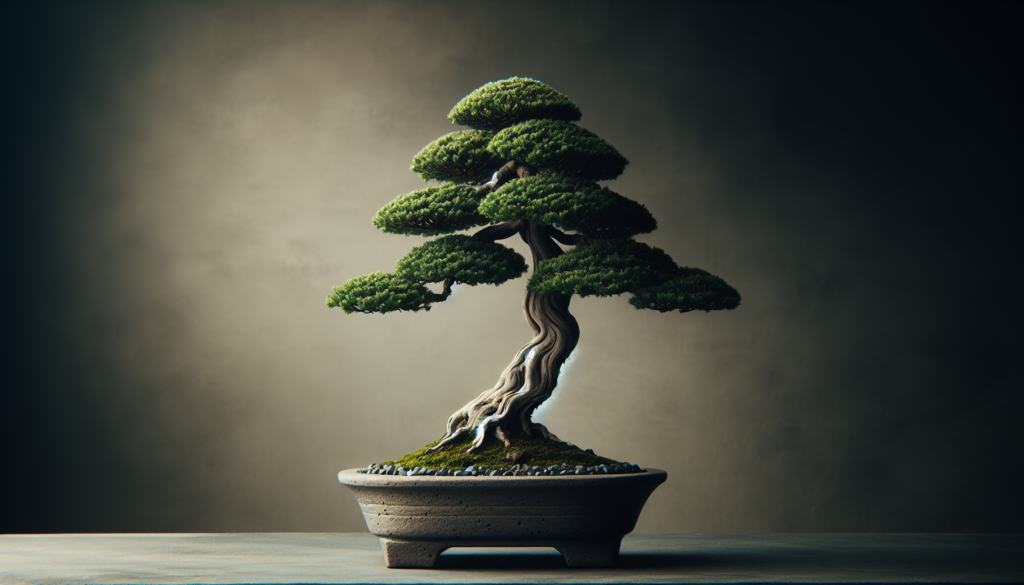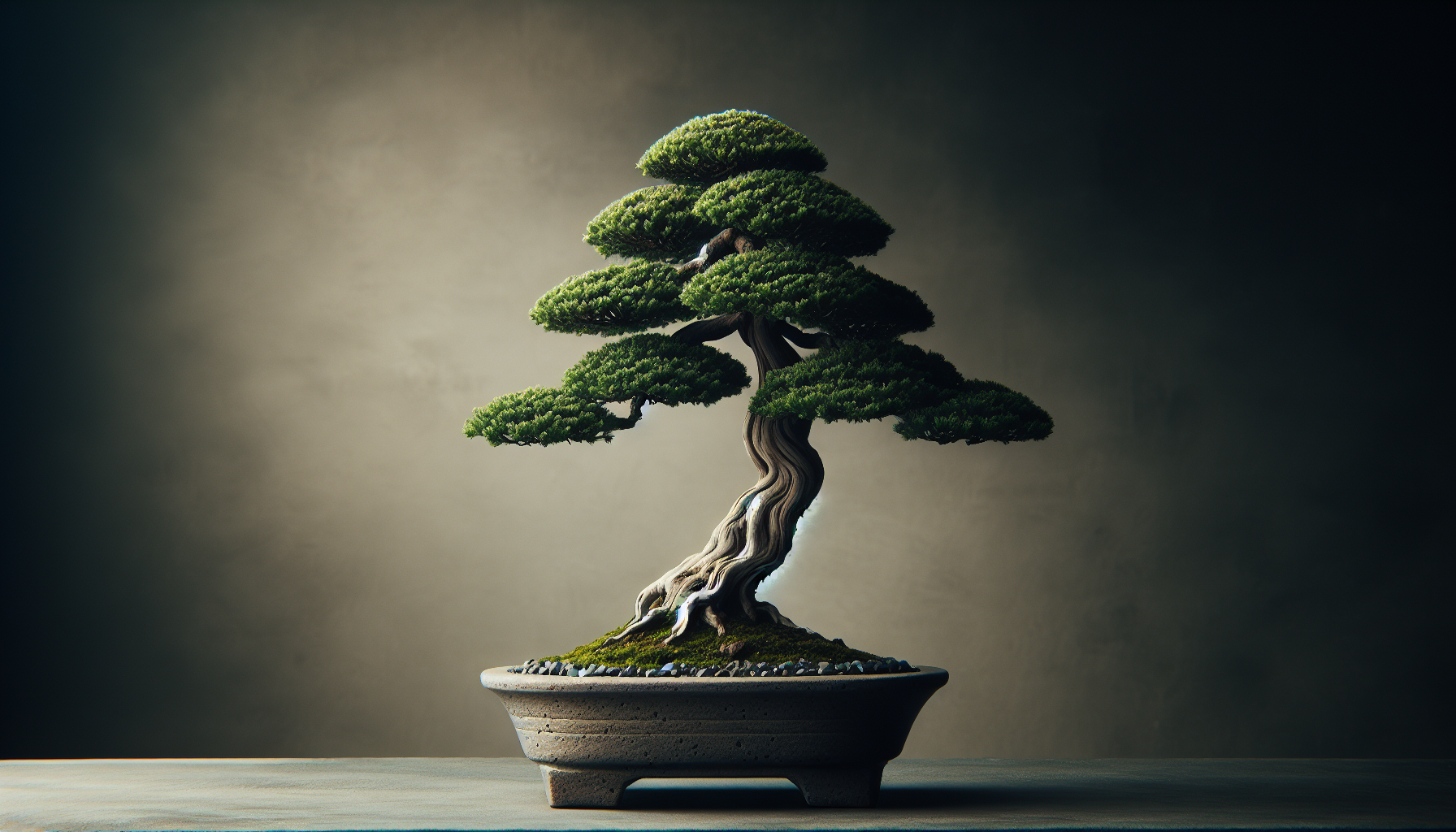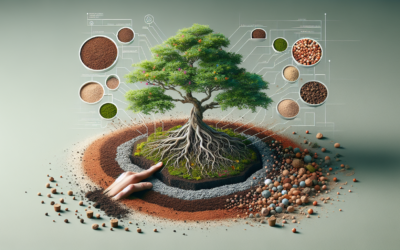Imagine creating a peaceful miniature garden in the comfort of your own home—one that fits perfectly in even the tiniest of spaces. With the art of bonsai, you can transform a small corner into a stunning display of nature’s beauty. In this article, we will explore the enchanting world of bonsai and how you can maximize your miniature garden, bringing tranquility and elegance into your life. From choosing the right tree to understanding the techniques of pruning and shaping, you will discover the secrets to creating a captivating bonsai masterpiece that will leave you in awe.
Understanding Bonsai Basics
Bonsai, the art of growing small trees in containers, originated in China over a thousand years ago and later spread to Japan, where it became popularized. The word “bonsai” itself means “tray planting” in Japanese. Bonsai involves carefully cultivating trees to mimic the shape and size of full-grown trees found in nature.
History and Origin of Bonsai
The history of bonsai can be traced back to ancient China, where it began as a form of artistic expression among the elite class. The practice gradually spread to Japan during the Heian period (794-1185), where it took on its unique Japanese aesthetics and philosophy.
Bonsai Styles and Forms
There are several different styles and forms of bonsai, each with its own specific characteristics and design principles. Some popular styles include formal upright, informal upright, slanting, cascade, and semi-cascade. Each style aims to capture the essence of nature and create a harmonious balance between the tree and its container.
Types of Bonsai Trees
A wide variety of tree species can be trained as bonsai. Some popular choices include pine, maple, juniper, ficus, and elm. Each type of tree has its own specific care requirements, growth patterns, and aesthetic qualities. It is important to choose a tree that suits your climate, available space, and personal preferences.
The Spirit and Philosophy of Bonsai
Bonsai is not simply a horticultural practice but also embodies a deep philosophical and spiritual connection with nature. the art of bonsai encourages patience, focus, and a keen observation of the natural world. It teaches us to appreciate the beauty and transience of life, as reflected in the miniature ecosystem we create.
Planning Your Miniature Garden
Before diving into the world of bonsai, it is essential to plan your miniature garden to ensure a successful and aesthetically pleasing outcome. Here are some key considerations to keep in mind.
Choosing the Right Location
When selecting a location for your bonsai garden, it is important to consider factors such as sunlight, temperature, humidity, and air circulation. Most bonsai thrive in well-lit areas with indirect sunlight. Additionally, it is crucial to protect your bonsai from extreme weather conditions and strong winds.
Designing with Limited Space
One of the charms of bonsai is its ability to thrive in small spaces. Whether you live in an apartment or have a limited outdoor area, bonsai is a perfect choice for adding greenery and beauty to your surroundings. Consider utilizing vertical space, hanging baskets, or even creating a bonsai forest to maximize limited space.
Creating a Bonsai Theme
Another aspect of planning your miniature garden is deciding on a theme or style. You can choose to create a traditional Japanese garden with elements such as lanterns, stepping stones, and bonsai arranged in a balanced and harmonious manner. Alternatively, you can explore a more contemporary or experimental approach, incorporating elements that reflect your personal taste.
Balancing Your Bonsai with Other Elements
In addition to bonsai trees, your miniature garden can be enhanced by the inclusion of other elements such as rocks, water features, and accent plants. These elements can add depth, texture, and visual interest to your garden, creating a more dynamic and captivating display. Experiment with different combinations until you achieve a harmonious balance.
Choosing Your Bonsai Trees
Selecting the right bonsai tree is a crucial step in your bonsai journey. Consider the following factors to ensure you make an informed decision.
Factors to Consider When Choosing Bonsai
When choosing a bonsai tree, it is important to consider factors such as your climate, available space, and level of experience. Some trees are better suited for indoor cultivation, while others thrive in outdoor environments. Additionally, consider the growth characteristics and maintenance requirements of different tree species.
Indoor versus Outdoor Bonsai
Indoor bonsai trees are typically tropical or subtropical species that can thrive in the controlled environment of your home. They require specific care and maintenance routines, including providing adequate humidity and temperature conditions. On the other hand, outdoor bonsai trees are adapted to withstand the natural elements and often require less attention.
Understanding Bonsai Hardiness
Hardiness refers to a tree’s ability to withstand and survive winter cold temperatures. It is an essential consideration, especially if you live in a climate with harsh winters. Different tree species have varying levels of hardiness, and it is crucial to select a bonsai tree that can withstand the lowest temperatures in your area.
Popular Bonsai Choices for Small Spaces
Some popular bonsai choices for small spaces include ficus, jade, Japanese maple, and Chinese elm. These trees are known for their adaptability to indoor environments, compact growth habits, and beautiful foliage. Research specific care guidelines for each tree to ensure you can provide the necessary conditions for their healthy growth.

Bonsai Pot Selection
Choosing the right bonsai pot is not only a practical consideration but also plays a crucial role in the overall aesthetics of your bonsai. Consider the following aspects when selecting a bonsai pot.
Choosing the Right Bonsai Pot Size
The size of the bonsai pot should be proportionate to the size of the tree. A pot that is too large or too small can disrupt the visual balance of the bonsai and impede its development. As a general guideline, the width of the bonsai pot should be approximately two-thirds the height of the tree.
Material and Design of Bonsai Pots
Bonsai pots are typically made from materials such as ceramic, clay, or plastic. Each material has its own unique characteristics and aesthetic appeal. Ceramic pots are a popular choice due to their durability, natural appearance, and ability to retain moisture. Clay pots, on the other hand, offer excellent drainage properties.
The Role of Bonsai Pot in Bonsai Aesthetics
The choice of bonsai pot greatly affects the overall aesthetics of your bonsai. A well-selected pot can complement the tree’s shape, color, and texture, enhancing its natural beauty. Consider the characteristics of your bonsai tree when selecting a pot, ensuring they harmonize and create a visually pleasing composition.
Potting and Repotting Your Bonsai
Potting and repotting are essential tasks in bonsai care. Potting involves initially placing a young tree into a bonsai pot, while repotting is necessary to refresh the soil and root system periodically. The frequency of repotting depends on the tree species, growth rate, and overall health. It is crucial to follow proper techniques to avoid damaging the tree’s roots.
Planting and Shaping Your Bonsai
Proper planting and shaping techniques are fundamental to the development and maintenance of a healthy and aesthetically pleasing bonsai. Learn the following techniques to ensure your bonsai thrives.
The Bonsai Planting Process
The bonsai planting process typically involves carefully removing the tree from its nursery container, spreading its roots, and placing it into the bonsai pot. Care must be taken to position the tree correctly and ensure good contact between the roots and the soil. Proper watering and aftercare are essential to minimize transplant shock.
Basic Bonsai Wiring Technique
Wiring is a fundamental technique used to shape the branches and trunk of a bonsai tree. It involves wrapping flexible wire around branches and bending them into the desired position. However, caution must be exercised to avoid damaging the tree’s delicate tissue. Wiring should be done during the tree’s dormant period to reduce stress.
Pruning and Trimming Your Bonsai
Pruning and trimming are essential for maintaining the shape, health, and aesthetic appeal of your bonsai. Pruning involves the removal of overgrown or undesirable branches, while trimming focuses on maintaining the overall balance and proportions of the tree. Regular pruning and trimming help stimulate new growth and maintain the desired structure of your bonsai.
Handling Bonsai Growth Issues
Bonsai trees, like any living organism, are susceptible to various growth issues such as pests, diseases, and nutrient deficiencies. Regular inspection and proper care can help identify and address these issues early on. Familiarize yourself with common bonsai pests and diseases, and take appropriate measures to prevent or treat them.
Bonsai Care and Maintenance
Proper care and maintenance are essential for the long-term health and beauty of your bonsai. Pay attention to the following aspects to ensure your bonsai thrives.
Watering Your Bonsai
Watering is one of the most critical aspects of bonsai care. Achieving the right balance between underwatering and overwatering is crucial for the tree’s health. The frequency and amount of watering depend on factors such as climate, tree species, potting medium, and individual tree needs. Regularly monitor the moisture level of the soil and adjust your watering routine accordingly.
Fertilizing Your Bonsai
Proper fertilization helps provide essential nutrients for your bonsai’s growth and development. Use a balanced, slow-release fertilizer specifically formulated for bonsai. Apply fertilizer during the growing season, following the recommended dosage instructions. Remember to adjust fertilization frequency and strength based on the tree’s growth patterns and seasonal requirements.
Learning about Pest Control and Disease Prevention
Bonsai trees are susceptible to pests and diseases, which can have a detrimental effect on their health and aesthetics. Familiarize yourself with common bonsai pests and diseases, and implement preventive measures such as regular inspection, proper sanitation, and using organic pest control methods when necessary. Promptly address any signs of infestation or disease to minimize damage.
Handling Bonsai Seasonal Care
Bonsai trees require specialized care during different seasons. For example, protect your bonsai from frost and extreme cold temperatures during the winter months. In spring, ensure proper fertilization and protect against sudden temperature fluctuations. In summer, provide adequate water and protection from intense sun exposure. Adapt your care routine to suit the specific needs of your tree throughout the year.
Creating Multi-Tree Bonsai
Multi-tree bonsai, also known as forest or group planting, involves creating a miniature landscape with multiple trees. Explore the following considerations to create visually stunning multi-tree bonsai compositions.
Designing Group Planting Bonsai
Designing a group planting bonsai involves carefully selecting trees that complement each other in terms of size, shape, and color. Consider the growth patterns and characteristics of each tree to create an aesthetically pleasing composition. Arrange the trees in a way that resembles a natural forest, with varying heights, spacing, and angles.
Maintaining Harmony in Multi-tree Bonsai
Harmony is an essential aspect of multi-tree bonsai. Achieving a balanced and harmonious composition involves maintaining an appropriate proportion between the individual trees, creating a sense of depth and perspective, and ensuring each tree’s placement complements the others. Regular maintenance, including pruning and wiring, is necessary to maintain harmony as the trees continue to grow.
Avoiding Common Mistakes in Multi-Tree Bonsai
Creating multi-tree bonsai requires careful planning and attention to detail. Some common mistakes include overcrowding the composition, using trees that have conflicting growth patterns, and neglecting maintenance. It is essential to research, learn from experienced bonsai enthusiasts, and make incremental adjustments to achieve the desired effect.
Inspiring Multi-Tree Bonsai Examples
Looking at inspiring examples of multi-tree bonsai can provide valuable insight and inspiration for your own creations. Explore books, magazines, online forums, and bonsai exhibitions to discover a wide range of multi-tree bonsai styles, themes, and artistic interpretations. Each composition offers a unique perspective on the possibilities of this captivating bonsai style.
Incorporating Bonsai Landscapes and Accents
Creating a complete bonsai landscape involves incorporating various elements that enhance the overall visual impact and storytelling potential of your miniature garden.
Understanding Bonsai Landscape Concepts
Bonsai landscapes aim to recreate the beauty and tranquility of nature by combining miniature trees, rocks, accent plants, water features, and other elements. Understanding the principles of bonsai landscape design, such as asymmetry, balance, and creating focal points, can help you create a captivating and harmonious scene.
Adding Moss and Ground Covers
Moss and ground covers play a vital role in bonsai landscapes. They add a realistic touch, create depth, and visually anchor the trees in their miniature environment. Use appropriate moss species that thrive in the specific conditions of your bonsai garden. Regular care and maintenance, such as watering and grooming, are necessary to ensure their healthy growth.
Choosing and Adding Accent Plants
Accent plants, also known as companion or understory plants, are small shrubs, grasses, or flowers that complement and enhance the overall aesthetics of the bonsai landscape. Consider plants that have a similar growing environment and visual appeal to the bonsai trees. Place them strategically to create a sense of scale and harmony within the composition.
Using Rocks and Other Elements
Rocks are an essential element in bonsai landscapes, representing mountains, cliffs, or other geological features. Choose rocks that naturally complement the style, theme, and size of your bonsai trees. Additionally, consider incorporating elements such as miniature bridges, pagodas, or figurines to add interest, tell a story, or create a specific atmosphere in your miniature garden.
Maximizing Space using Vertical Bonsai
Vertical bonsai is an innovative approach that maximizes limited space by growing trees vertically. Explore the following aspects to create visually stunning and space-saving vertical bonsai compositions.
Introduction to Vertical Bonsai
Vertical bonsai, also known as “kokufu,” involves growing trees in a vertical, erect manner. This style allows for multiple trees to be grown in a compact, space-saving manner, ideal for small apartments or limited outdoor spaces. Vertical bonsai requires specialized training and techniques to ensure the trees grow upright and maintain their desired shape.
Tips for Designing Vertical Bonsai
Designing vertical bonsai involves selecting trees that naturally have an upright growth habit or can be trained vertically. Consider the size, shape, and leaf characteristics of each tree to create a visually pleasing composition. Proper pruning, wiring, and regular maintenance are essential to ensuring the trees grow vertically and maintain a compact form.
Care and Maintenance of Vertical Bonsai
Vertical bonsai requires specific care and maintenance to ensure the healthy growth of the trees and maintain their vertical form. Regular pruning, trimming, and wiring are necessary to shape the trees and maintain their upright posture. Adequate lighting, proper watering, and appropriate fertilization are essential for the overall health and vitality of the vertical bonsai.
Examples of Space-Saving Vertical Bonsai
There are numerous examples of stunning vertical bonsai compositions that showcase the beauty and innovation of this style. Explore photographs, books, and online resources to discover a wide range of vertical bonsai designs. From towering forests of slender trees to cascading arrangements, each composition offers a unique and creative approach to maximizing space with vertical bonsai.
Continuing Bonsai Education and Showcase
Bonsai is a lifelong journey of learning and growth. Engaging with the bonsai community, attending shows, and continuously expanding your knowledge are essential for your development as a bonsai enthusiast.
Joining Bonsai Clubs and Communities
Joining a bonsai club or community is a valuable way to connect with like-minded individuals who share your passion for bonsai. These communities provide opportunities for learning, sharing experiences, and gaining insights from experienced bonsai enthusiasts. You can participate in workshops, attend meetings, and even collaborate on group projects.
Attending Bonsai Shows and Exhibits
Bonsai shows and exhibits are excellent opportunities to learn from experts, see exceptional bonsai specimens, and gain inspiration for your own creations. These events often feature demonstrations, workshops, and lectures by renowned bonsai artists. Whether you are a beginner or an experienced enthusiast, attending bonsai shows can deepen your understanding and appreciation of the art form.
Continuing to Learn and Grow in Bonsai Art
Bonsai is a lifelong journey of learning and refinement. Continuously expanding your knowledge through books, articles, online resources, and workshops will enhance your understanding of bonsai techniques, aesthetics, and horticultural practices. Stay curious, experiment, and never be afraid to ask questions or seek guidance from experienced practitioners.
Showcasing Your Bonsai Garden
As you progress on your bonsai journey, you may want to share your achievements and creations with others. Organizing your own bonsai exhibition or participating in local competitions can be a gratifying way to showcase your bonsai garden. This not only allows you to receive recognition for your efforts but also provides an opportunity to inspire others and contribute to the wider bonsai community.
In conclusion, bonsai offers a fascinating and rewarding way to cultivate nature in miniature form. By understanding the basics of bonsai, planning your miniature garden, choosing the right trees and pots, mastering planting and shaping techniques, caring for your bonsai, exploring unique styles and themes, and continuously learning and growing, you can create a beautiful and thriving bonsai garden that brings joy and tranquility to your living space. Happy bonsai gardening








